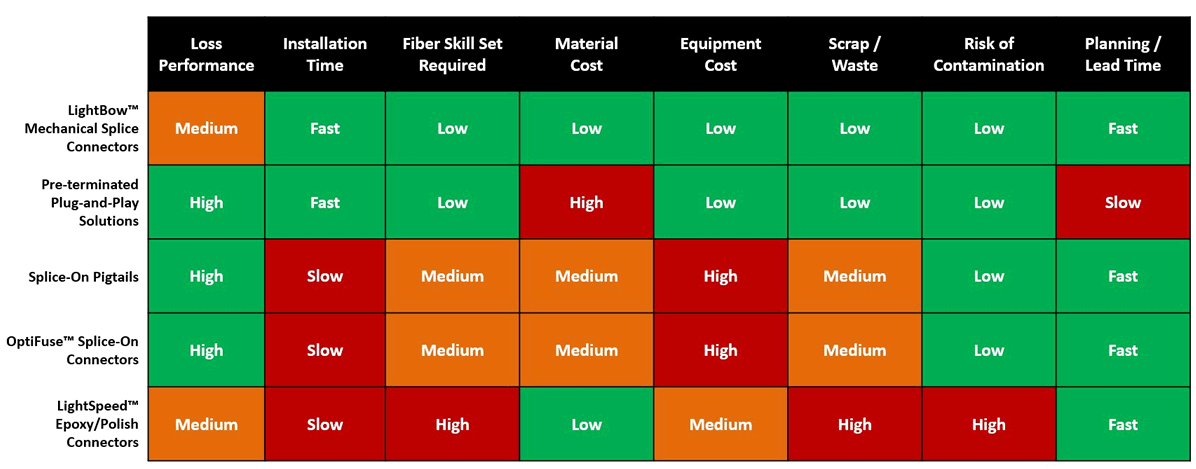データセンターや通信室における光ファイバー成端方式の選定ポイント
データセンターや通信室で光ファイバーリンクを構築する際には、あらかじめ成端されたケーブル(プレ成端品)や融着接続、現場成端型のコネクタなど、複数の成端方式から選択する必要があります。
どの方式を選ぶかは、いくつかの重要な要素を考慮することで、より自社の要件に合った最適な選択が可能になります。
まず第一に検討すべきは、現在のアプリケーション要件や機器インターフェースの仕様、そして**将来的なスケーラビリティ(拡張計画)**です。
たとえば、100GBASE-SR4や200GBASE-SR4のような高速パラレル光アプリケーションを導入する予定がある場合、MTP/MPOといった多芯コネクタが必要となります。これらのコネクタは、すべての成端方式に対応しているわけではないため、方式選定に制限が生じることがあります。
もちろん、予算も重要な検討項目ですが、それに加えて以下のような点も考慮すべきです:
• 接続数と工事スケジュール
• 挿入損失性能の要件
• インストーラーのスキルレベル
• 設置環境の特性(データセンターか、屋外か、など)
これらの要素を踏まえたうえで、それぞれの成端方式について詳しく見ていきましょう。

高密度・高速伝送に対応するSiemonのBase 12 / Base 8プレ成端ソリューション
SiemonのBase 12およびBase 8プレ成端ソリューションは、マルチモード/シングルモードファイバーおよびMTP/MPO、LC、SC、STなど多様なコネクタインターフェースに対応しています。
工場であらかじめ成端されたケーブルアセンブリは、エンクロージャ内のモジュールやカセットに差し込むだけで簡単に接続可能。設置の手間を大幅に軽減しながら、安定した性能を確保します。
低損失仕様やMTP/MPO-デュプレックスのハイブリッド構成にも対応しており、高速パラレル光アプリケーションやブレークアウト接続に最適です。
⸻
【用途例】
• 100GBASE-SR4
• 200GBASE-SR4
• 400GBASE-SR8 などの高速光通信環境
【利点】
• 現場作業の省力化:事前成端により、現場での接続作業を最小限に
• 確実な品質:工場出荷時に検査済みの高信頼アセンブリ
• スピーディな導入:短納期・短工期を実現し、早期稼働に貢献
プレ成端ソリューションの特長と導入メリット
工場で100%成端・検査済みのプレ成端ソリューションは、現場ではプラグアンドプレイで迅速に接続が可能なため、光ファイバーの成端スキルを必要とせず、施工品質のバラつきを抑えた高い性能を実現します。
また、梱包資材や消耗品が少なく、現場廃棄物も抑制できることから、環境負荷の低減にも貢献します。
【導入メリット】
• 大規模・高密度配線に最適:配線空間を節約し、多芯ファイバーの迅速な接続を実現
• 最大90%の導入時間短縮:事前設計によって、現場作業の効率が大幅に向上
• 高品質で安定した性能:すべてのアセンブリが出荷前に検査済み
【コストに関する考慮点】
プレ成端方式は受注生産のため材料コストはやや高めですが、ケーブル長の事前計画が適切であれば、作業時間と人件費の削減効果により、全体としてコストパフォーマンスに優れるケースが多くあります。
【適さないケース】
• 低芯数のデュプレックス配線では、コスト効率が見合わない場合があります
• 災害復旧や緊急展開など、即応性が求められる場面には不向き(製造リードタイムが必要なため)
スプライスオンピグテール(Splice-On Pigtails)
スプライスオンピグテールは、マルチモード・シングルモード双方に対応し、デュプレックスおよびシンプルックスのLC、SC、さらに多芯のMTP/MPOコネクタタイプで提供されています。
スプライスオンピグテールは、あらかじめ研磨されたコネクタから短いファイバースタブが突出しており、これを**融着接続(フュージョンスプライス)**により、既設の光ファイバーに接続します。
この接続には、両端を適切に切断(クリーブ)したファイバー同士を正確に位置合わせし、電気アークで融着させる専用の融着接続機器が必要です。
また、多芯リボンケーブルの12本ファイバーを同時に融着接続できるマスフュージョンスプライサーも利用可能で、大量接続作業の効率化に貢献します。

スプライスオンピグテールは、接続損失が非常に低く(約0.1dB程度)、反射も最小限に抑えられる高信頼な接続を提供します。
この方式は、外部敷設光ファイバー(250µm)から屋内用光ケーブル(900µm)への接続に最適であり、多様なサービスプロバイダーからの光ファイバーが引き込まれるクラウドやコロケーションデータセンターの入線設備で広く採用されています。
さらに、プレ成端ソリューションに比べて材料コストが抑えられ、現場廃棄物も少ないことがメリットです。また、ケーブル長を正確に計画する必要がなく、長納期の懸念もありません。
⸻
【留意点】
• 融着接続機器を所有していない場合、接続作業にかかるコストは高くなります(機器のレンタル利用は可能)
• 融着接続部を保護するためのスプライストレイやスリーブの追加コスト・設置スペースが必要
• 接続性能は、切断面(クリーブ)の品質に強く依存するため、高品質なクリーバーの使用が推奨されます
• 作業時間はプレ成端に比べて長くなる傾向があり、作業に適したスペースの確保も求められます

スプライスオンコネクター
工場であらかじめ研磨されたスプライスオンコネクターは、マルチモード・シングルモード双方に対応し、LCまたはSCのシンプルックスコネクターで提供されています。
スプライスオンピグテールとは異なり、ファイバースタブはコネクター内部に内蔵されており、スタブ部分を融着接続した後、フェルール周辺にコネクター部品を組み立てる構造です。
工場であらかじめ研磨されたスプライスオンコネクターは、マルチモード・シングルモード双方に対応し、LCまたはSCのシンプルックスコネクターで提供されています。代表的な製品として、OptiFuse™があります。
スプライスオンピグテールとは異なり、ファイバースタブはコネクター内部に内蔵されており、スタブ部分を融着接続した後、フェルール周辺にコネクター部品を組み立てる構造です。
スプライスオンピグテールと同様に、強固で低損失な接続を実現し、ケーブル長の事前計画は不要です。ただし、融着接続機器と高品質なクリーブ作業は必須となります。
本製品は、250µm被覆ファイバー、900µmタイトバッファードファイバー、900µmブレークアウトキットの成端に対応しています。
さらに、スプライスオンコネクターは、スプライストレイや保護スリーブが不要で、接続部がコネクターのハウジング内で保護されるため、資材の削減や光ファイバーエンクロージャ内のスペース節約につながります。これにより、ピグテール方式と比較して施工時間を最大30%短縮できるメリットもあります。
現場成端コネクター(Field-Terminated Connectors)
融着接続を必要としない現場成端コネクターには、大きく分けて以下の2種類があります。
1. エポキシ/研磨タイプコネクター
SC、LC、STコネクターで提供され、マルチモード・シングルモードの双方に対応しています。代表的な製品にLightSpeed™コネクターがあります。
2. 機械式スプライスコネクター
SC、LCコネクターで提供され、マルチモード・シングルモード対応のものもあります。代表的な製品にLightBow™コネクターがあります。
⸻
特長と適用シーン
現場成端コネクターは、超高密度設置や、1コネクターあたりの挿入損失が0.2dB未満といった非常に厳しい性能要件には最適とは言えませんが、低芯数の配線、修理や再構成には非常に適しています。
特に、プレ成端品のように事前計画や長いリードタイムが取れない現場や、高価な融着機器を保有していない施工者にとっては有効な選択肢です。
⸻
エポキシ/研磨タイプのポイント
エポキシ樹脂を使ってファイバーとコネクターフェルールを接着し、硬化させた後、突き出たファイバーを切断(クリーブ)および研磨して滑らかな仕上げを行います。
熟練の技術者には好まれる方式ですが、技能が限定的な場合は、挿入損失が平均0.2~0.3dB程度にとどまらず、さらに悪化する可能性もあります。
また、現場で研磨された端面は露出しているため、汚染防止に十分な注意が必要です。

メカニカルスプライスコネクターは、アライメントフィクスチャー内でインデックスマッチングジェルを用いてファイバー同士を接合する方式で、現場成端コネクターの中でも近年人気が高まっています。
この方式は、硬化時間が不要で迅速に成端できること、比較的簡単に施工可能なこと、そしてエポキシ/研磨タイプに比べて消耗品が少なく廃棄物も抑えられる点が大きなメリットです。
メカニカルスプライスコネクターを選定する際には、LightBowシステムのように、電源やバッテリーを必要としない低コストの成端工具を用い、1分以内でコネクターを成端可能な製品を検討することをおすすめします。すべてのメーカーの製品がこれに対応しているわけではありません。
また、LightBowのように成端中もダストキャップを装着したまま作業できるタイプは、汚染リスクが低減できるという利点もあります。
成端方式選びをサポートします
光ファイバー成端方式の選定をよりスムーズに進めていただけるよう、以下に各方式の比較サマリーをご用意しました。
また、専門技術サポートチームが常にご相談を承っており、お客様のご状況やご予算に最適なソリューションをご提案いたします。
どの方式をお選びいただいても、当社のAdvanced Fiber Solutions.では、幅広い成端オプションを一括してご提供していますので、ご安心ください。






